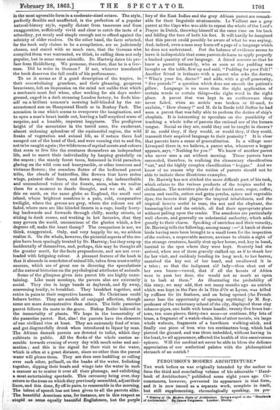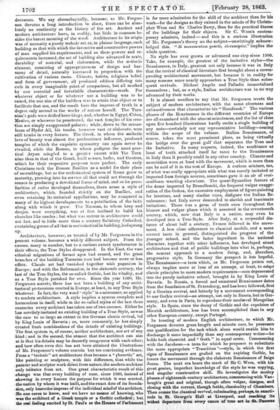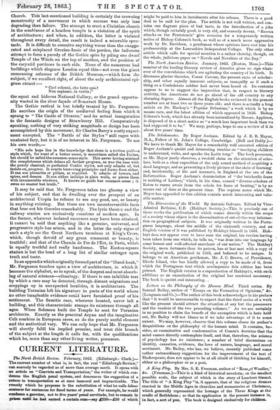FERGUSSON'S MODERN ARCHITECTURE.*
THE work before us was originally intended by the author to form the third and concluding volume of his admirable Hand- book of Architecture," published some eight years ago. Cir- cumstances, however, prevented its appearance in that form, and it is now issued as a separate work, complete in itself, but still supplementing, chronologically speaking, its pre- • History of the Modern Styles of Architecture. Being a eequel to the "Handbook of Architecture.' By James Fergusson. London : Murray. decossors. We say chronologically, because, as Mr. Fergus- son devotes a long introduction to show, there can be abso-
lutely no continuity as the history of the art. Ancient and modern architecture have, in reality, but little in common be- sides the barest meaning of the word. Architecture in its origin was of necessity a purely technic art or, in plainer language, such building as that with which the inventive and constructive powers of man supplied his requirements, and as these powers and re- quirements increased, the art of building also advanced in scale, durability of material, and elaboration, while the aesthetic element, consisting of appropriateness of design and har- mony of detail, naturally increased in proportion with the cultivation of various races. Climate, habits, religious belief, and form of government, all produced edifices differing tote cce/o in every imaginable point of comparison, but all marked by one essential and invariable characteristic—truth. For whatever object or for whatever use a building was to be raised, the one aim of the builders was to attain that object or to facilitate that use, and the result bore the impress of truth in a degree only second to the works of nature herself. The Tura-
nian's gods were deified hero-kings, and, whether in Egypt, China, Mexico, or wherever he penetrated, the vast temples of his erec-
tion are simply exaggerated palaces ; while, down to the mauso- leum of Hyder Ali, his tombs, however vast or elaborate, were still tombs in every feature. The Greek, in whom the aesthetic love of beauty was almost the predominant influence, produced temples of which the exquisite symmetry can again never be rivalled, while the Roman, in whose pedigree the more prac- tical Aryan mingled to a greater extent with the Tura-
nian than in that of the Greek, built sewers, baths, and theatres, which for their respective purposes were perfect. The early
Christians took the Roman Basilica as a model for their place of assemblage, but as the ecclesiastical system of Rome grow to maturity, pressing into its service all that could act through the senses in producing a devotional frame of mind, and as its pecu- liarities of cakes developed themselves, there arose a style of architecture, which, founded strictly on the Basilica, and even retaining its technical appellations, may be compared in many of its highest developments to a petrifaction of the faith along with which it grew. The Norman, to whom keep and donjon were everything, was at first inclined to build his -churches like castles ; but what was untrue in architecture could not last, and in little more than a century Salisbury Cathedral, -containing germs of all !hat is ecclesiastical in building,had sprung op.
Architecture, however, as treated of by Mr. Fergussou in the present volunie, becomes a widely different subject. From the causes, many in number, but to a curious extent synchronous in their effects, the True Styles disappeared. In the East, the vast ethnical migrations of former ages bad ceased, and the great branches of the building Turanian race had become more or less -effete. Classic art had 'vanished together with paganism in Europe; and with the Reformation, in the sixteenth century, the last of the True Styles, the so-called Gothic, lost its vitality, and as a True Style perished for ever. Since the year 1500, Mr. Fergusson asserts, there has not been a building of any archi- tectural pretensions erected in Europe, at least, in any True Style whatever. In fact, the very word "style" is a misnomer, as applied
to modern architecture. A style implies a system complete and harmonious in itself, while in the so-called styles of the last three centuries every architect has taken one of two courses. Either he has servilelyimitated an existing building of a True Style, as was the case to so large an extent in the German classic revival, led by King Louis of Bavaria ; or, more commonly, he has simply -created fresh combinations of the details of existing buildings. The first system is, of course, neither architecture, nor art of any Mind ; and in the second, the utmost that the architect can aim at is that his details may be decently congruous with each other; and how often even this has not been attained the illustrations of Mr. Fergusson's volume contain- but too convincing evidence. From a "technic" art architecture thus became a " phonetic" art, like painting or sculpture, with this difference, that while the painter and sculptor work dit'ect from nature, the modern architect only imitates from art. One great characteristic result of this change was that every building of note, since 1500, instead of showing in every feature the purpose for which it was erected, .the nation by whom it was built, and the exact date of its founda- tion, only bears the impress of the individual mind of the architect. Ifo one cares to know, and we have no means of knowing, who was the architect of a Greek temple or a Gothic cathedral; but the real feeling excited by St. Paul's or the Houses of Parliament is far more admiration for the skill of the architect than for his work—for the designs as they existed in the minds of Sir Christo- pher Wren and Sir Charles Barry, than for the practical fitness of the buildings for their objects. Sir C. Wren's contem- porary admirers, indeed— and this is a curious illustration of Mr. Fergusson's theory on the subject—unwittingly acknow- ledged this. "Si monumentum quzeris, circumspice," implies the whole question.
No style has ever grown or advanced one step since 1500. Take, for example, the greatest of the imitative styles—the Renaissance, in Italy, greatest not only because it was in Italy that the revival of classical literature first brought about a corres- ponding architectural movement, but because it in reality for many reasons more nearly approaches a True Style than subse- quent revivals. Michael Angelo and Palladio immortalized themselves ; but, as a style, Italian architecture was in no way advanced by their works.
It is almost needless to say that Mr. Fergusson treats the subject of modern architecture, with the same clearness and exhaustiveness that characterize his " Handbook." The various phases of the Renaissance in the different countries of Europe are all examined with the utmost minuteness, and the list of close upon five hundred illustrations hardly omits a single building of any note—certainly not any representative building—coming within the scope of the volume. Italian Renaissance, -of course, takes the most prominent place, as being virtually the bridge over the great gulf that separates the True and the Imitative. In many respects, indeed, the semblance -at least of truth attached itself far more to the Renaissance in Italy than it possibly could in any other country. Climate and association were at least with the movement, which is more than can be said of it in the rest of Europe. A curious mixture, too, of what was really appropriate with what was merely imitated or imported from foreign sources, sometimes gave it an air of vrai- semblance wanting elsewhere. The quasi-Byzantine feature of the dome imported by Brunelleschi, the frequent vulgar exagge- ration of the Orders, the excessive employment of figure-painting for interiors, and many similar vices, disfigure the Italian Re- naissance; but Italy never descended to slavish and inanimate imitations. There was a germ of truth even throughout the bizarre and vulgar phase which it assumed in the seventeenth century, which, now that Italy is a nation, may even be developed into a True Style. After Italy, at a respectful dis- tance of about half a century, France followed in the move- ment. A less close adherence to classical models, and a more correct taste in general, distinguished the progress of the younger school, and the latter ingredient in the national character, together with other influences, has developed street architecture and that of public buildings into what is, perhaps, the nearest approach to a modern living, and, therefore, progressive style. In Germany the prospect is less hopeful. The Renaissance—a term which, as Mr. Fergusson points out, always implies more or less of an attempt, at least, to adapt classic principles to more modern requirements—soon degenerated into the purely imitative school, brought in by King Louis of Bavaria. In Russia, a forced and unnatural Renaissance dates from the foundation of St. Petersburg, and has been followed, first by a Grecian revival, and latterly by a movement corresponding to our Gothic revival—an attempt, not only in Russia, but in Ger- many, and even in Paris, to reproduce their medimval Mongolian style. In Spain, since the decay of Gothic and the expulsion of Moorish architecture, less has been accomplished than in any other European country, except Portugal.
In treating of modern English architecture, to which Mr. Fergusson devotes great length and minute care, he possesses one qualification for the task which alone would enable him to discharge it more impartially than any contemporary writer—he holds both classicist and " Goth " in equal scorn. Commencing with the Jacobean—a term for which he proposes to substitute the more appropriate " Transition "—style, in which the first signs of Renaissance are grafted on the expiring Gothic, he traces the movement through the elaborate Renaissance of Inigo Jones. The next era bears the mark of Sir C. Wren, with his great genius, imperfect knowledge of the style he was copying, and singular constructive skill. He investigates the motley phases of eighteenth-century architecture, commencing with Van- brugh's great and original, though often vulgar, designs, and
closing with the correct, though feeble, classicality of Chambers. Then comes the classical revival, culminating, perhaps, in exacti- tude in St. George's Hall at Liverpool, and reaching its widest departure from every canon of true art in St. Pancras
Church. This last-mentioned building is certainly the crowning monstrosity of a movement in which success was only less degrading than failure. The attempt to erect a Christian church in the semblance of a heathen temple is a violation of the spirit of architecture; and when, in addition, the letter is violated throughout every detail, the result is indeed a miserable spec- tacle. It is difficult to conceive anything worse than the exagge- rated and misplaced Grecian-Ionic of the portico, the ludicrous attempt to form a parody of the Gothic spire by piling one dwarf Temple of the Winds on the top of another, and the position of the caryatid porticoes in each side. None of the numerous bad buildings which disgrace London equal this—not even tho giant unmeaning columns of the British Museum,—which form the subject, if we recollect right, of about the only architectural epi- gram extant :—
" Cari colonni, the fatto quk?
Non sapiamo, in verita ;"
the squat and hideous National Gallery, or the grand opportu- nity wasted in the river facade of Somerset House.
The Gothic revival is but briefly treated by Mr. Fergusson. He ascribes the origin of the medireval feeling from which it sprang to " The Castle of Otranto," and its actual inauguration to the fantastic designs of Strawberry Hill. Comparatively
speaking, nothing of very striking magnitude or design has been accomplished by this movement, Sir Charles Barry's costly experi-
ment excepted. The " Battle of the Styles" still rages with
unabated fury, but it is of no interest to Mr. Ferguson. To use his own words,— "His sole hope lies in the knowledge that there is a tertium
style which, for want of a better name, is sometimes called the Italian, but should be called the common-sense style. This never having attained the completeness which debars all further progress, as was the case with the purely classical, or perfected Gothic styles, not only admits of, but insists on, progress. It courts borrowing principles and forms from either. It can use pinnacles or pillars, as required. It admits of towers, and spires, and domes. It can either indulge in plain walls, or pierce them with innumerable windows. It knows no guide but common sense ; it owns no master but truth."
It may be said that Mr. Fergusson takes too gloomy a view of his subject, and that in dwelling over the prospect of an architectural Utopia he refuses to see any good, use, or beauty in anything existing. But there are two incontrovertible facts that bear out his theories remarkably. The lyric theatre and the railway station are exclusively creations of modern ages. In the former, whatever isolated successes may have been attained, it cannot be said that anything like a genuine, universal, and progressive style has arisen, and in the latter the only signs of such a style are the Great Northern terminus at King's Cross, which, though devoid of any great ornament or beauty, is truthful; and that of the Chemin de Fer de l'Est, in Paris, which is equally truthful and really handsome. The Euston-square station is but the head of a long list of similar outrages upon truth and taste.
In an appendixwhich originally formed part of the "Hand-book," Mr. Fergusson touches upon a view of architecture, in which it becomes the alphabet, so to speak, of the deepest and most absorb- ing of natural sciences—ethnology. If there is one infallible test by which a race may be detected, through distant migrations and
croppings up in unexpected localities, it is architecture. The building Turanian left his signature in parts of the world where no other imaginable evidence could have furnished proof of his settlement. The Semitic race, wherever located, never left a building, and this characteristic stamps its existence through all ages. When Solomon built the Temple he sent for Turanian architects. Exactly as the practical Aryan and the imaginative Celt combine in European races, so do the purely useful element and the sestbetical vary. We can only hope that Mr. Fergusson will shortly fulfil his implied promise, and treat this branch of the subject at the length it calls for, with the qualifications which he, more than any other living writer, possesses.
































 Previous page
Previous page